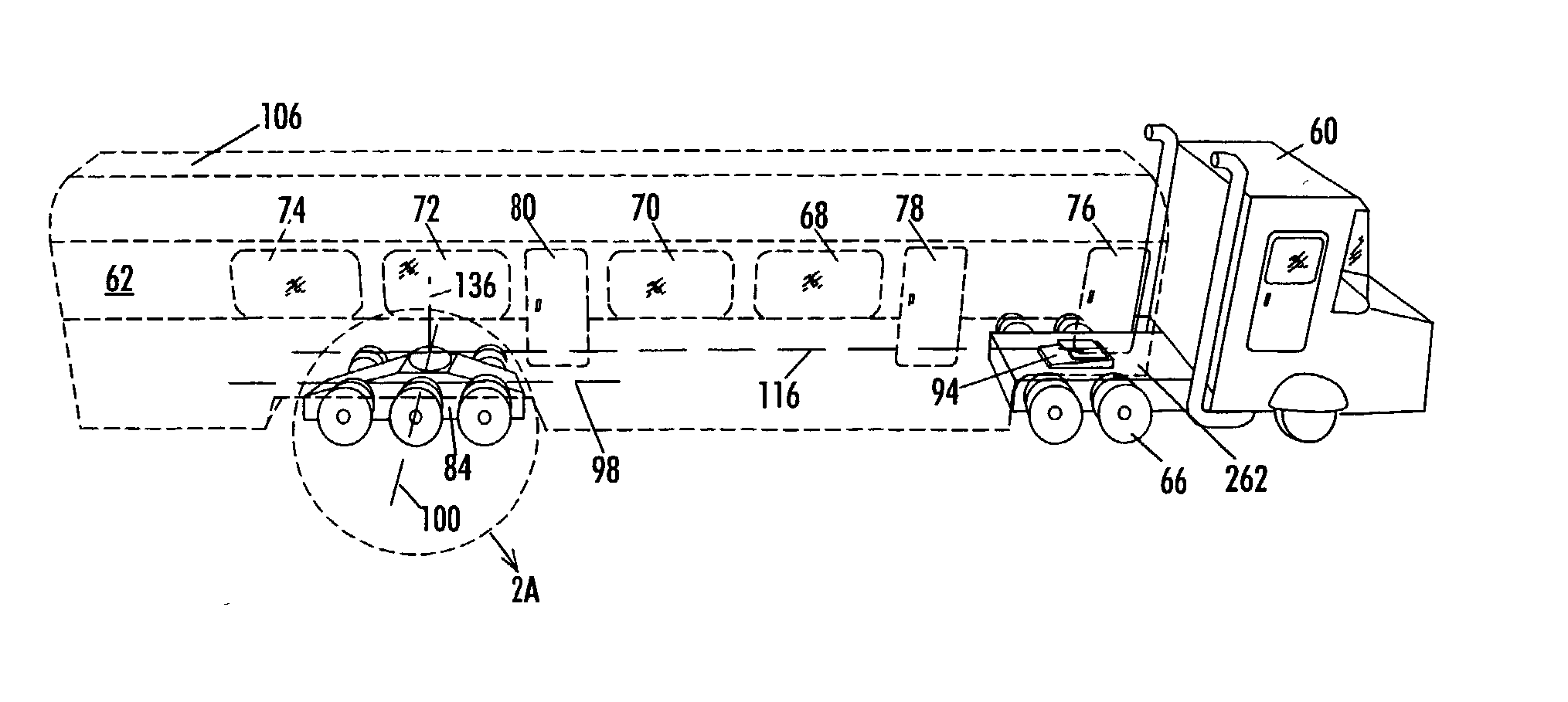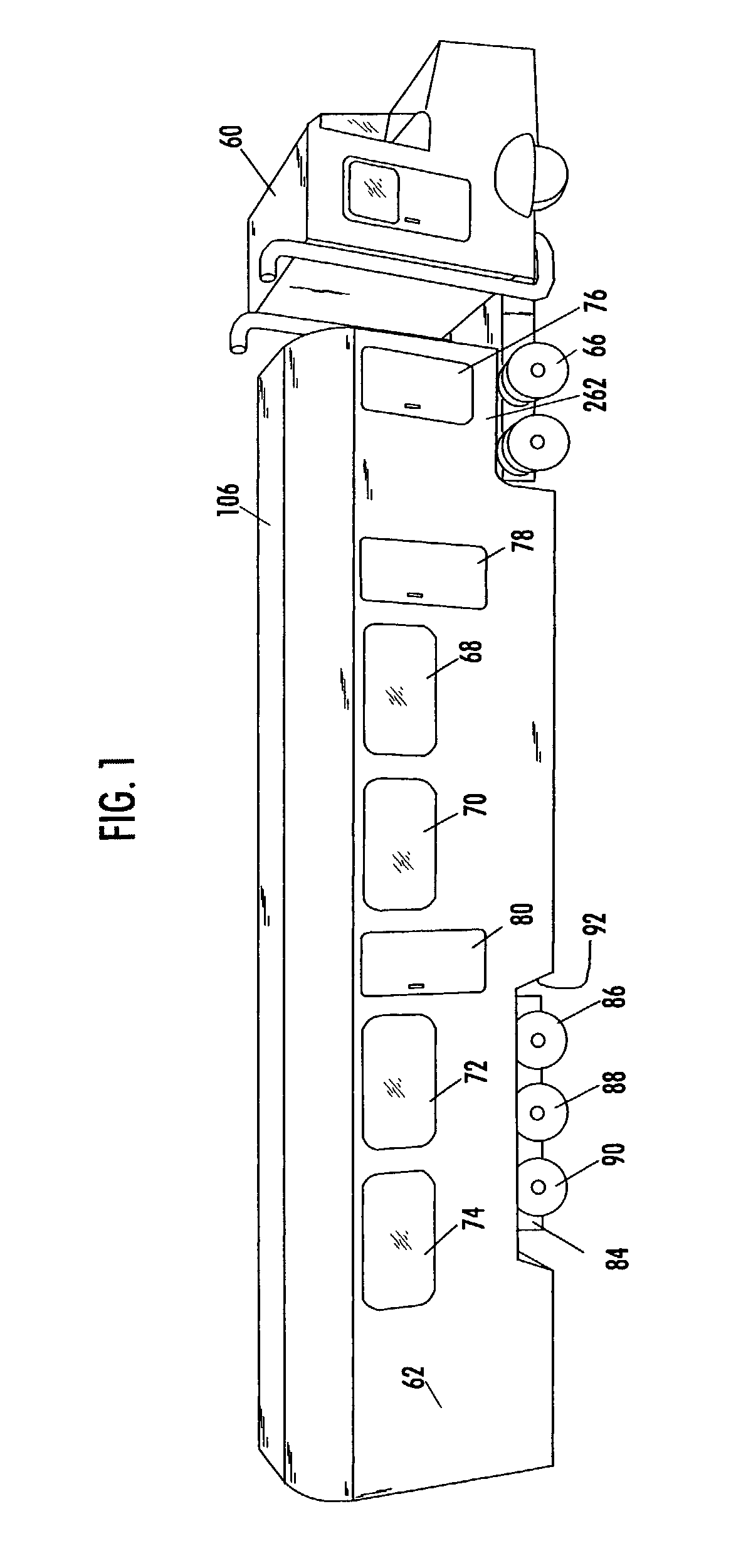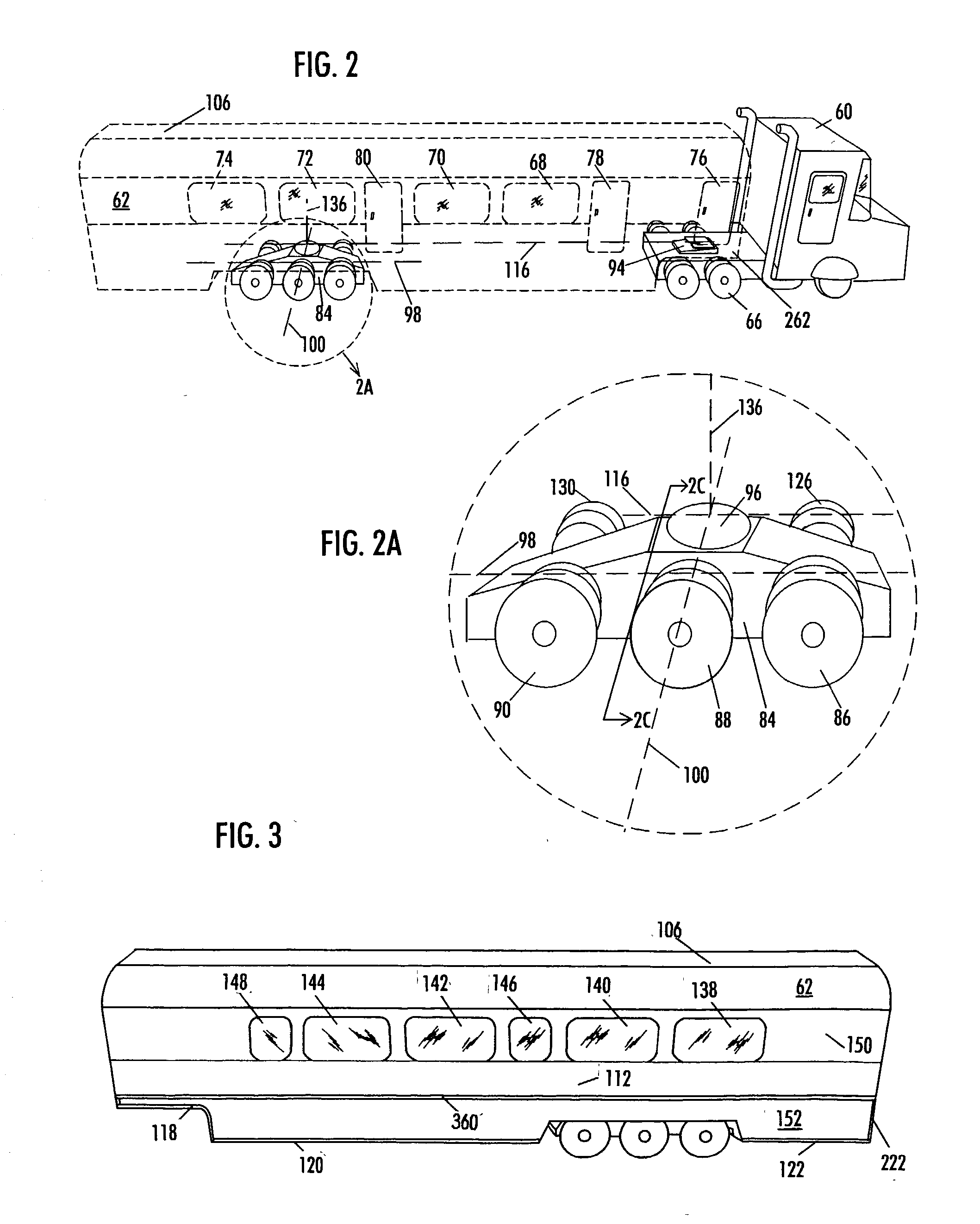The existing prior art has not improved on the problem of high vehicle centers of gravity.
Fully occupied motorcoach busses suffer a similar
operational problem where the passenger seating is higher, e.g. a center of gravity point which may be five to six feet above the
road surface as compared a regular
bus and articulated
bus configurations which have a somewhat lower center of gravity point.
Both prior art groupings do not utilize high strength bulkheads which could be an important component in a cabin rollcage structure, all of which could act as redundant structures should the cabin portions of the vehicle experience a
rollover event, further the two prior art groups do not employ high strength cabin sideplates which will provide a higher level of
crashworthiness in
side impact events.
Notably, the lightweight
vehicle frame structure design criteria as illustrated by U.S. Pat. No. 5,577,793, Kobasic, is not crashworthy.
Further, lightweight passenger
vehicle frame construction is easily prone to lengthwise torsional distortions for a vehicle that is largely manufactured of formed transverse, vertical and lengthwise sheetmetal channel members as described in U.S. Pat. No. 4,254,987, Leonardis, a design which is equally not a crashworthy.
Continuing, the articulated omnibus U.S. Pat. No. 4,342,370, Hagin et al, also fails to mention a
crashworthiness design criteria in its specifications and claims.
Although this is a successful design in that it is very low to the ground for ease of passenger access, it can also be prone to vehicle length torsional distortions that can easily exceed the design criteria of its rotary junction member.
Yet, as the background discussion clearly indicates, such a low-level floor design feature restricts the structural strength of the vehicle, hence the
crashworthiness of this passenger vehicle is not addressed in either the specifications or the claims.
However, since formed lightweight sheetmetal channel beams are easily subject to lengthwise torsional distortions and the vehicle structure, as described in the patent, lacks any mention of high strength cabin formers, high strength cabin bulkheads and high strength cabin sideplates in the specifications and claims, the vehicle does not have a fail-safe, crashworthiness design.
Further, much like the semi-trailer prior art and articulated
bus prior art, the vehicle-length sidewall modules in Waldeck limit the vehicle design to the conventional straight sided cabin and do not provide a method for creating variable contoured exterior profiles for the vehicle cabin.
What is most obvious with this narrow box beam floor construction is that the outboard sections of the floor structure where seats should be placed simply does not provide any obvious structural attachment points for those seats which puts the issue of crashworthiness for that patent into serious question.
Since the transverse end frame is not covered by a high strength lower cabin sideplate for
side impact events, such an event would cause the cabin structure, stiffened by its roof members, to collapse in a sideways `trapezoidal` fashion.
Further, a vehicle
rollover event could also cause a similar sideways cabin collapse.
Further still, a head-on collision event could cause a cabin collapse in a `domino` fashion due to the weak lower transverse end frame joints.
Additionally, this
vehicle frame design lacks cabin bulkheads that would act as redundant structures in
side impact events.
Finally, because there is no vehicle wide floorplate nor are there any high strength cabin sideplates which would essentially form a vehicle length channel stiffening structure to which the box section hoops could be welded, the vehicle is prone to longitudinal twisting much like any other lightweight vehicle frame.
Further, because the flat-
bed portion of the semi-trailer supports wheel units at each end, the conventional suspension apparatus used by those wheel units will exert both bending and torsional distortions upon the flat-
bed portions of the vehicle, especially when it is heavily loaded and is travelling over uneven road surfaces.
However, since the mobile home closed box beam underframe is only about a foot in height and all current versions of this design can range from 12 to 16 feet in width and up to 80 feet in length, it can be understood that this substantially sized structure can easily be distorted by uneven road surfaces even if it were constructed of
metal members.
As the drawings for Steck shows, the design has two vehicle-length internal `I` beam spars, however it is designed as a lightweight vehicle
chassis only which is not produced to withstand any extensive over-the-road operations without incurring a variety of structural failures.
Even though the specifications claim an improved strength-to-weight ratio for the vehicle
chassis, the specifications
neglect to mention the presence of an alternate path, fail-safe
construction design should two of its four primary longitudinal members of the vehicle
chassis fail to meet their design loads.
The Boyles and the two Garcia designs have an operating center of gravity point of the semi-trailer which is substantially above the surface of the road making this high center of gravity problem, coupled with the designed-in chassis flexibility, a problematical situation.
Particularly so with the Garcia designs where the combination of chassis flexibility and high vertical center of gravity points can only lead to vehicle
instability on turns and uneven road surfaces, particularly where the load can oscillate in a lateral fashion.
This is an undesirable operating characteristic which can lead to
rollover accidents, much like those accidents which are associated with cylindrical tanker semi-trailer designs which also have a high vertical center of gravity point, in
spite of their stiffened chassis design.
Further, the specifications for Garcia fail mention a fail-safe alternate path structural loading design should any of its primary
load bearing members fail to support their
design load.
Nevertheless, because of the extraordinarily flexible and unique structural makeup of the Boyles vehicle, it is equally incapable of safely carrying regular freight or tanker fluid loads and is therefore not of a crashworthy design in those respects.
One articulated bus U.S. Pat. No. 4,342,370, Hagin et al, did properly take into account the longitudinal weight and balance question during the manufacturing phase but did not address the subject during the operational phase.
However, from an operational point of view, the inventor did not take into consideration a most common situation with articulated busses of this type which are now in operation in most large communities.
Since this design is a towed vehicle identical to that of a towed semi-trailer, a reduction of
towing traction, particularly during turns or during icy road conditions, could cause a jackknifing event.
A second failure mode is the conventional suspension apparatus whereby the
mechanical failure of the conventional suspension apparatus or its related chassis attachment hardware which structurally attaches to the vehicle chassis and other vehicle members can cause serious
vehicle control problems which can easily lead to accidents and passenger injuries.
However, from practical and safety standpoints, the subject of operational recoils are a natural outgrowth of the methods of construction for conventional suspension apparatus which has not been substantially addressed by conventional suspension apparatus prior art, especially where the conventional suspension apparatus directly supports the vehicle axle.
If the vehicle has a high operational vertical center of gravity point, it is predisposed to a potential rollover event, more so if the suspension is won on the side of the vehicle tilt and the suspension on that side is incapable of meeting its intended load requirements.
This
operational problem has been addressed by the suspension prior art which offered a wide array of complex vehicle self-leveling systems and apparatus, however, the passenger semi-trailer prior art and the articulated bus prior art does not address nor incorporate any self-leveling suspensions in either their specifications or their claims.
As with a large majority of conventional suspension apparatus, air bag suspensions can fail if any of the hoses that supply air pressure leak or if the air bags themselves develop leaks, therefore the suspension prior art does not address future failure
modes for their particular suspension designs and are therefore, not fail-safe designs.
From the conventional suspension apparatus point of view for the passenger semi-trailer prior art and the articulated bus prior art, these vehicles have not incorporated a fail-safe suspension in either their specifications or claims.
In these two designs, a king bolt failure would cause separation of the suspension from the chassis.
Using either single or dual air chambers, any cracks or
tears in any of the flexible diaphragms would cause a collapse of the suspension apparatus which is not of a fail-safe design.
Although the manufacturing tradeoff is a heavier but more crashworthy vehicle, this weight and
balance design feature, acting cooperatively with the wheel unit shaft mechanical intervention with the lower structure module, substantially lessens the possibility that the vehicle will experience rollover events which are a major design problem for both semi trailers in general and other passenger busses such as motorcoach busses where the passenger seating is at a higher level than that of conventional passenger busses.
 Login to View More
Login to View More  Login to View More
Login to View More 


